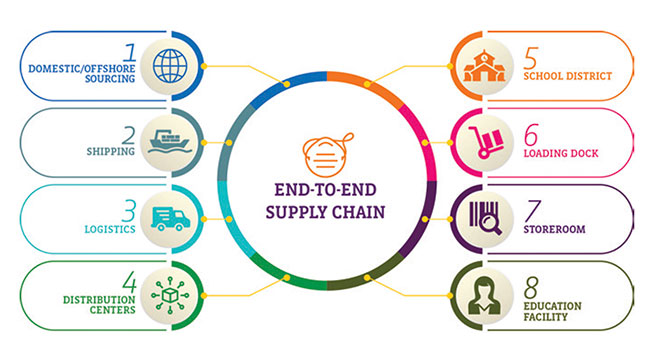
Tips for Overcoming the Supply Chain Crisis
The unprecedented nature of the COVID-19 pandemic exposed gaps in the supply chain but also provided opportunities to strengthen it. We’ve realized that many K–12 school districts and higher ed institutions have outdated models for supply chain management and procurement, and they lack the technological platforms and processes that other industries have put into place.
“Supply chain” is now a common household term. For educators and school administrators, ongoing supply chain disruptions continue to create challenges in their nutrition programs, course materials and equipment, and the learning environment itself.
When the COVID-19 pandemic first hit, district leaders and higher ed administrators were forced to scramble and rapidly adapt operations to ensure the safety of students and staff. Many realized they didn’t have access to the personal protective equipment (PPE) and facility maintenance supplies they needed, because it was the first time school systems had ever needed to procure such large quantities of these materials. Education leaders were tasked with identifying reliable suppliers who could deliver high-demand supplies.
The pandemic exposed the faults of conventional wisdom regarding supply chains: that it’s most efficient and effective to have a single supplier or source for materials. Especially when demand is high, it’s best to have access to a large and diverse pool of suppliers and manufacturers. This strategy not only helps with ensuring access to supplies but also helps get them at the lowest possible cost.
Our ability to pivot to remote/hybrid working and learning environments served us well. We learned that we can do this in the future, if and when it happens again. But as schools shifted back to in-person learning, we also learned of the growing importance of maintaining the built environment and the impact of indoor air quality, lighting, and our overall facilities on educational outcomes.
What we learned about the supply chain and its impact on educational facilities
One of the lessons from this pandemic and resulting supply chain crisis is that the parts supply chain is highly fragmented and completely disconnected from the education facilities management strategy. This is not too different from the industrial space. Maintenance organizations will prioritize training, reliability, and technology while almost completely ignoring the parts supply chain, even though it is clear that their maintenance supplies and spare-parts supply chain is mission-critical and essential to their ability to deliver on their mission.
This article originally appeared in the March / April 2022 issue of Campus Security & Life Safety.

